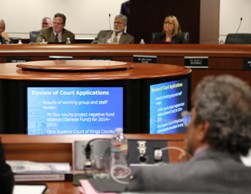Council Approves Supplemental Funding for Kings Court
Contact: <a href="mailto:blaine.corren@jud.ca.gov">Blaine Corren</a>, 415-865-7740
October 28, 2014
Council Approves Kings Court’s Request for Supplemental Funding
Requests from Del Norte, Mono, and Siskiyou courts denied

SAN FRANCISCO—At its public meeting on October 27–28, the Judicial Council approved a request from the Superior Court of Kings County for $509,000 in supplemental funding in fiscal year 2014─2015 to help cover a budget shortfall created by an emergency need to replace its failing case management system.
The council is required by statute to set aside each fiscal year 2% of the total funds appropriated in the Trial Court Trust Fund to support operations of the trial courts. The set-aside funds must be used to establish a state-level reserve for trial courts that suffer unforeseen and unavoidable funding shortfalls.
Adhering carefully to this criteria, the council denied supplemental funding requests from the superior courts in Del Norte, Mono, and Siskiyou Counties. While acknowledging and sympathizing with their dire budget situations created by years of budget reductions to the judicial branch, the council ultimately decided that these courts’ budget shortfalls did not meet the supplemental funding criteria. In addition, the council recognized that any supplemental funding approved for one court would ultimately come out of the statewide pot set aside for all trial courts.
“This is one of those difficult decisions that the Judicial Council has had to make pretty regularly in the last four years,” said Chief Justice Tani G. Cantil-Sakauye, chair of the council. “This is exactly the reason why the council is a statewide policymaking body, and we face problems as a statewide judiciary. We need to advocate as a branch for adequate new investment to address the budget reductions and reduced levels of services affecting all of our courts.”
Members of the Trial Court Budget Advisory Committee and Judicial Council staff stated their commitment to reach out to courts that have requested supplemental funding, and other courts seeking assistance, to help find viable solutions to their budget challenges.
Other items on the October 27–28 council meeting agenda included:
Changes to 2% State-Level Reserve Process: The council approved recommendations from its Trial Court Budget Advisory Committee to expedite the return of unallocated reserve funding to trial courts earlier in the fiscal year and to establish a process for courts to apply for emergency funding after the reserve funds are distributed. The council, starting this fiscal year, can distribute in January―after the council’s December business meeting—75 percent of the remaining reserve funds. From January 1 through March 15, the remaining 25 percent of the reserve would be available for courts to request for unforeseen emergencies or unanticipated expenses. Any reserve funds remaining after March 15 would be distributed back to trial courts based proportionally on the amount of money they contributed to the reserve. If an emergency arises after March 15, courts can request a cash advance against funding they would receive in the next fiscal year.
Napa County’s Seismic Experience: The council heard a report about the judicial branch’s response to the August 24 earthquake that damaged the Napa Historic Courthouse and other local buildings, and the implications for courthouses statewide. Many of California’s courthouses are at critical seismic risk. A significant earthquake would cause structural damage, total disruption of court operations, and possible loss of life. Said Justice Brad Hill, chair of the Court Facilities Advisory Committee, “Recent damage to the Napa courthouse is a graphic reminder that if we fail to provide the public and our court staff with safe and secure courthouses, the result could be devastating. That quake occurred in the middle of the night. But if a quake like that occurs in one of our facilities in the middle of the day, we'll be giving you a much different report.” Napa’s historic courthouse is expected to be closed for two to four years, and all of its operations—including half of its judges and two-thirds of its staff—had to be moved to its overcrowded criminal courthouse.
Final Report of Self-Represented Litigants Task Force: The council received the final report from its task force charged to implement the Statewide Action Plan for Serving Self-Represented Litigants. This report identifies parts of the plan that have been put into place—such as establishing self-help centers in every county—and those that remain to be done. For example, the report recommends that the council seek additional funding to expand court self-help centers, education and technical assistance, and interpreters in family law cases and other non-courtroom family law services.
Adoption and Permanency Month Resolution: The council adopted a resolution proclaiming November to be Court Adoption and Permanency Month. The proclamation recognizes the ongoing efforts of California’s juvenile courts and their justice partners―such as Adoption Saturdays and expedited adoption proceedings―to provide children and families with access to fair, understandable judicial proceedings that lead to just permanency outcomes. About 62,500 children in California live apart from their families in child welfare-supervised out-of-home care, and 38 percent of those children in foster care have lived apart from their families for two or more years.
An archived audiocast of the entire meeting broken out by topic will be available on the October 27─28 council meeting webpage later this week.
###
